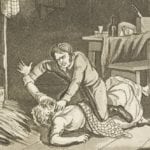 Weird Stuff
Weird Stuff  Weird Stuff
Weird Stuff  Our World
Our World 10 Ways Your Christmas Tree Is More Lit Than You Think
 Movies and TV
Movies and TV The 10 Coolest Stars to Set Sail on The Love Boat
 History
History 10 Things You Didn’t Know About the American National Anthem
 Technology
Technology Top 10 Everyday Tech Buzzwords That Hide a Darker Past
 Humans
Humans 10 Everyday Human Behaviors That Are Actually Survival Instincts
 Animals
Animals 10 Animals That Humiliated and Harmed Historical Leaders
 History
History 10 Most Influential Protests in Modern History
 Creepy
Creepy 10 More Representations of Death from Myth, Legend, and Folktale
 Technology
Technology 10 Scientific Breakthroughs of 2025 That’ll Change Everything
 Weird Stuff
Weird Stuff Ten Bizarre Facts About The Doge Meme
 Our World
Our World 10 Ways Your Christmas Tree Is More Lit Than You Think
 Movies and TV
Movies and TV The 10 Coolest Stars to Set Sail on The Love Boat
Who's Behind Listverse?

Jamie Frater
Head Editor
Jamie founded Listverse due to an insatiable desire to share fascinating, obscure, and bizarre facts. He has been a guest speaker on numerous national radio and television stations and is a five time published author.
More About Us History
History 10 Things You Didn’t Know About the American National Anthem
 Technology
Technology Top 10 Everyday Tech Buzzwords That Hide a Darker Past
 Humans
Humans 10 Everyday Human Behaviors That Are Actually Survival Instincts
 Animals
Animals 10 Animals That Humiliated and Harmed Historical Leaders
 History
History 10 Most Influential Protests in Modern History
 Creepy
Creepy 10 More Representations of Death from Myth, Legend, and Folktale
 Technology
Technology 10 Scientific Breakthroughs of 2025 That’ll Change Everything
10 More Serial Killers Who Were Never Identified
For every notorious serial killer who is caught and punished for their crimes, there are many others who get away with it and remain unidentified. In some serial killer cases, there is a promising suspect, but not enough evidence to charge them with the crimes. In other cases, the killer may have died or been incarcerated for another crime, but no one ever connected them to the unsolved murders. Of course, not every serial killer becomes as famous as Jack the Ripper or the Zodiac Killer, but that doesn’t make them any less creepy.
10 The Atlanta Ripper

Over 20 years after Jack the Ripper terrorized London, the city of Atlanta was terrorized by their own unknown serial killer, who murdered what is estimated to be between 15 and 21 African-American women throughout 1911-12. Rosa Trice was believed to be his first victim after she was found murdered on the morning of January 22. Her head was crushed by a blunt instrument and she had been stabbed in the jaw and had her throat slit. Many more African-American or dark-skinned women would be brutally murdered in a similar fashion over the next few months. By the time June rolled around, the killer had finally garnered the attention of the press and was dubbed “The Atlanta Ripper.”
On July 1, a young woman named Emma Lou Sharpe was waiting for her mother, Lena, to return home from grocery shopping. When Lena didn’t show up, Emma Lou went searching for her and encountered an African-American man wearing a black-rimmed hat. He stated, “I would never hurt girls like you,” before suddenly pulling out a knife and stabbing Emma Lou in the back. She managed to escape and survive, but later found out the assailant had murdered her mother. One week later, another woman had an encounter with this same unidentified man before running away. Many different suspects were questioned and police made attempts to indict some of them for the murders, but no one could be conclusively proven to be the Atlanta Ripper.
Get inside the heads of history’s most depraved humans with Serial Killers: The Method and Madness of Monsters at Amazon.com!
9 Stoneman

The most notorious serial killer in the history of India was known simply as “Stoneman” and he is believed to have committed 13 murders in Calcutta in 1989. His first victim was murdered in June of that year after being bashed over the head with a stone. The victim was a homeless pavement-dweller who was sleeping alone in a dimly lit area when he was killed. Over the course of the next six months, 12 more homeless people would be murdered in the exact same fashion and many of the victims were never even identified.
Earlier, in 1985, at least a dozen homeless people were murdered in Bombay after having their heads bashed with a stone while they slept. This led authorities to suspect that the Bombay and Calcutta murders might have been committed by the same person. Investigators could not conclusively determine if all of the Calcutta victims were killed by the same person or if Stoneman helped inspire some copycat murders. Many suspects were arrested and questioned, but there was not enough incriminating evidence to charge anyone with the murders, so all the suspects were ultimately released. However, the killings did come to an abrupt end after the arrests, so one of those suspects could have very well been the notorious Stoneman.
8 The Honolulu Strangler

The first known serial killer on the island of Hawaii was the Honolulu Strangler, who is believed to have murdered five women during the mid-1980s. On the morning of May 30, 1985, the body of 27-year-old Vicky Gail Purdy was found in an embankment. She had been raped and strangled and her hands were bound behind her back. The killer was believed to have struck again on January 14, 1986 after 17-year-old Regina Sakamoto missed her bus to school. Her body was found the next day. Like the first victim, she had also been raped and strangled and her hands were bound behind her back.
Over the next three months, three more women—Denise Hughes, Louise Medeiros, and Linda Pesce—would be murdered in the exact same fashion. Before Linda Pesce was discovered, an informant told police that a psychic had told him the exact location of her body, which turned out to be incorrect. However, when Pesce was found within the same vicinity, the informant became a suspect. His girlfriend claimed that whenever the two of them had a fight, the suspect would leave their house, and these incidents seemed to coincide with the nights of the murders. The suspect was interrogated and failed a polygraph test, but was ultimately released due to lack of evidence. Months later, a woman claimed she had seen this man with Linda Pesce on the night of her murder. The suspect died in 2005 and no one could actually prove he was the Honolulu Strangler, but it’s worth noting that the murders stopped immediately after he became a suspect.
7 The Colonial Parkway Killer

Between 1986 and 1989, the 23-mile Colonial Parkway in Virginia was plagued by a series of unsolved murders. On October 12, 1986, the bodies of a young lesbian couple, Cathleen Thomas and Rebecca Ann Dowski, were found inside their vehicle, which was pushed down an embankment on the parkway. They had both been strangled and had their throats cut. One year later, another young couple, David Knobling and Robin Edward, were found shot to death in a nearby wildlife refuge.
On April 9, 1988, Cassandra Lee Hailey and Richard Keith Call disappeared while driving home from a party and their abandoned vehicle was found on the parkway the next morning. While their bodies have never been found, they are believed to be victims of the killer. In 1989, Annamaria Phelps and Daniel Lauer also went missing after driving on the parkway and their bodies were found on a nearby logging road a month later. Authorities believe these crimes were all committed by the same person and theorize that he may have been a law enforcement officer, or posed as one in order to get the victims to pull over. In 2011, a former deputy sheriff named Fred Atwell was investigated as a possible suspect after he held a phony car raffle to raise money for the victims’ families and allegedly pocketed the money for himself. However, there is no evidence to tie him to the murders, so the Colonial Parkway Killer’s identity remains unknown.
6 The Freeway Phantom

For 16 months in the early 1970s, a killer known only as “The Freeway Phantom” took the lives of six African-American girls in Washington, D.C. His first known victim was 13-year-old Carol Spinks, who was abducted while walking home from the store on April 25, 1971. Six days later, her body was found in an embankment near I-295. She had been raped and strangled. On July 8, 16-year-old Darlenia Johnson was also abducted, raped, and strangled. Her body was discovered in the exact same vicinity where Carol Spinks had been found.
Three weeks later, 10-year-old Brenda Crockett failed to return from the store and made two frantic phone calls to her home, claiming she was being held in a house by a white male. Her body would be discovered near the interstate hours later. Within the next few months, two more African-American girls would be raped and murdered in the exact same fashion, and one of the victims had a note signed by the Freeway Phantom, which read: “This is tantamount to my insensitivity to people especially women.” In March 1977, 58-year-old Robert Elwood Askins was charged with abducting and raping a woman. He had a long history of violence against women and was considered a likely candidate to be the Freeway Phantom. However, no hard evidence could be found that linked Askins to the crimes and he always maintained his innocence until his death in 2011.
5 The I-70 Killer

The 2,100-mile I-70 runs from Baltimore, Maryland to Cove Fort, Utah and became the calling card for an unidentified serial killer in 1992. The killer would visit random businesses in close proximity to Interstate 70 and senselessly shoot the employees. The first victim was an Indianapolis shoe store clerk named Robin Fuldauer, who was murdered on April 8. Three days later, the same killer entered a bridal shop in Wichita, Kansas and forced the two employees, Patricia Magers and Patricia Smith, into the back room before shooting them. A male customer just happened to walk into the store when the armed suspect emerged from the back, but he inexplicably let the witness go.
The I-70 Killer would soon claim two more victims in Terre Haute, Indiana and St. Louis, Missouri. On May 7, an employee named Sarah Blessing was shot to death at a gift shop in broad daylight at a Raytown, Missouri strip mall. This time, several other people at the mall caught a glimpse of the killer as he headed toward the interstate. Their eyewitness accounts matched the description of the suspect provided by the witness in Wichita, and ballistic tests would confirm that all these murders were committed by the same man. However, given how quickly the murders came to a stop, it’s been speculated that the killer may have been arrested for another crime not long afterwards. While numerous people have been suspected of being the I-70 Killer, he has yet to be positively identified.
Click here to start watching your favorite HBO shows with Amazon Prime Instant Video! Enjoy a 30 day free trial at Amazon.com!
4The Connecticut River Valley Killer

On October 25, 1978, the body of 27-year-old Cathy Millican was found in a wetland preserve in New London, New Hampshire. She had been stabbed 29 times. Over the course of the next decade, her killer is believed to have been responsible for the murders of at least six more women in the Claremont, New Hampshire and Connecticut River Valley areas. Most of the victims were found with multiple stab wounds. However, the killer’s activity in the area seemed to come to a halt after one of the victims survived his attack.
On the evening of August 6, 1988, a pregnant woman named Jane Boroski pulled into a convenience store parking lot in West Swanzey. She was attacked and stabbed multiple times by an unidentified male assailant, who left her for dead and drove away. Boroski survived the attack and drove off to find help, but was soon horrified to discover that she had inadvertently caught up with her attacker’s vehicle and was now driving directly behind him! Thankfully, she was able to make it to a friend’s house and received medical attention. Over the years, Boroski has come to believe that her attacker was a Vietnam veteran named Michael Nicholaou, who would become a suspect in the disappearance of his wife in late 1988. In 2005, Nicholaou murdered his new wife and stepdaughter before killing himself. However, authorities have been unable to conclusively determine if he was actually the Connecticut River Valley Killer.
3 Charlie Chop-Off

On March 9, 1972, the body of an eight-year-old African-American boy named Douglas Owen was found on a Manhattan rooftop. He had been stabbed 38 times and his penis was mutilated. One month later, another 10-year-old black youth was stabbed and subject to genital mutilation, but ultimately wound up surviving. Over the course of the next year, two nine-year-old boys, Wendell Hubbard and Luis Oritz, would be stabbed to death before having their penises removed, which led to the killer being nicknamed “Charlie Chop-Off.” On August 8, 1973, an eight-year-old black boy named Steven Cropper was murdered on a rooftop with a straight razor, but did not suffer any genital mutilation.
In 1974, a man named Erno Soto was arrested after making a failed attempt to abduct a Puerto Rican boy and he eventually confessed to the murder of Steven Cropper. However, he never did claim to be Charlie Chop-Off and the surviving victim could not positively identify Soto as his attacker. Soto had undergone numerous stays in a mental hospital over the years and may have actually been incarcerated at the time of Cropper’s murder. Given Soto’s history of mental illness, no one could be sure his confession was valid and there was no other evidence tying him to any of the murders, so he was ultimately found not guilty by reason of insanity and sent to a mental institution. However, since the Charlie Chop-Off murders came to a halt following Soto’s arrest, police have always considered him the mostly likely suspect.
2 The Frankford Slasher

From 1985 to 1990, the Frankford neighborhood of Philadelphia was shaken by a series of unsolved murders. The first victim was discovered on August 8, 1985 when the body of 52-year-old Helen Patent was found in a railway maintenance yard. She had been stabbed 19 times and sexually assaulted. She was also nude from the waist down and had her blouse pushed up to expose her bare chest. Five months later, 68-year-old Anna Carroll was found stabbed to death in her apartment. Like the first victim, she was nude from the waist down and had her blouse pushed up. The killer would eventually be dubbed “The Frankford Slasher” and over the course of the next four years, he was believed to be responsible for the deaths of seven more women. Some of these victims were seen with an unidentified, middle-aged white man shortly before their deaths.
When 46-year-old Carol Dowd was found murdered behind a fish market in 1990, authorities looked at one of the employees, Leonard Christopher, as a suspect. He was eventually given a life sentence for Dowd’s murder and was also accused of being the Frankford Slasher. However, since Christopher was black, he did not match the description of the white male seen with the other victims. In fact, the Slasher murdered Michelle Dehner—the woman believed to be his last victim—after Christopher was already in jail. Many people still think that Leonard Christopher did not kill Carol Dowd and was not the Frankford Slasher. If true, the real killer continues to get away with murder.
1 The Original Night Stalker/East Area Rapist

One of the most notorious serial killers of all time was Richard Ramirez, a.k.a. “The Night Stalker,” who terrorized the Los Angeles area during the mid-1980s and recently passed away while on death row. However, Ramirez’s reign of terror was actually preceded by an unidentified California serial killer known as the “Original Night Stalker.” His first known murder victims were Dr. Robert Offerman and his girlfriend, Debra Alexandra Manning, who were shot to death in their Goleta home on December 30, 1979. Over the course of the next seven years, the killer would claim seven more victims by breaking into their homes and bludgeoning them to death. In 1996, DNA tests would confirm that all these murders were committed by the same person.
In the late 1970s, an unidentified assailant known as the “East Area Rapist” terrified the Sacramento area and Contra Costa County by breaking into the homes of at least 50 women and raping them. He would initially target women who were home alone, but eventually started targeting couples, often forcing the female to tie the male up before he assaulted her. His string of rapes would abruptly stop when the decade came to end. In 2001, DNA testing allowed investigators to make an incredible discovery: the East Area Rapist and the original Night Stalker were the exact same person! Since his crimes seemed to stop after 1986, it’s speculated that he may have died, moved away from the area, or been imprisoned for another crime. He remains one of the most prolific criminals of all time, but his identity is still unknown.
Robin Warder is a budding Canadian screenwriter who has used his encyclopedic movie knowledge to publish numerous articles at Cracked.com. He is also the co-owner of a pop culture website called The Back Row and recently worked on a sci-fi short film called “Jet Ranger of Another Tomorrow.” Feel free to contact him here.







![10 Creepiest Photos Of Victims Taken By Serial Killers [DISTURBING] 10 Creepiest Photos Of Victims Taken By Serial Killers [DISTURBING]](https://listverse.com/wp-content/uploads/2018/09/Regina-Kay-Walters-featured-2-150x150.jpg)
